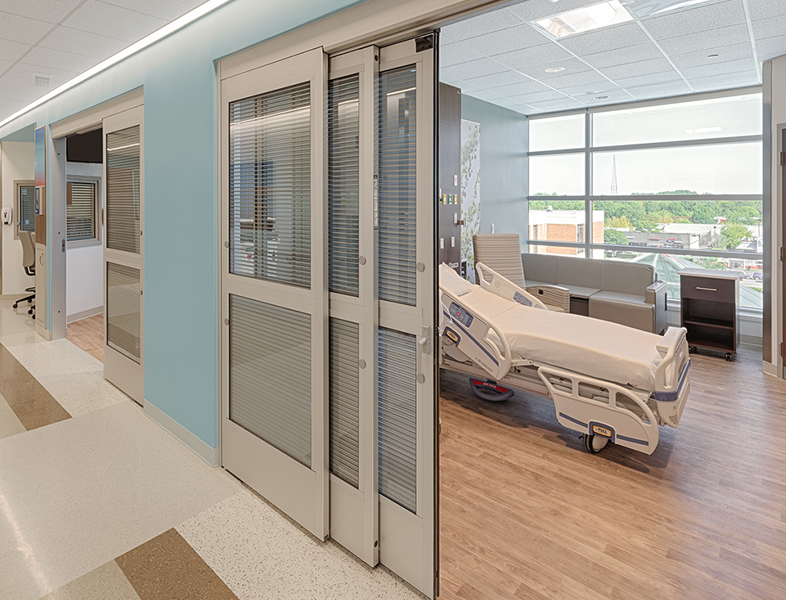Buildings clad in large sheets of uninterrupted glass are relatively commonplace today. But this was an unthinkable concept before developing structural glazing capable of bearing heavy loads.
So what is structural glazing, what are its advantages and disadvantages, and how can it potentially help your next project? Let’s dive in.
What is Structural Glazing?
Structural glass and glazing is glass that bears some of the structure’s weight. It’s composed of panels of reinforced, load-bearing glass usually held together by a strong silicone adhesive, allowing architects to create buildings or building components that appear fabricated from nothing but glass.
Structural glazing is traditionally used in glass skyscrapers but now has many other applications, from glass floors to minimal glass windows with no discernable frame. The glass within structural glazing is typically either laminated, monolithic, double-glazed, or triple-glazed insulating glass units (IGUs).
The sheer strength of structural glazing means it doesn’t need a heavy-looking frame to hold it up like most traditional glazing applications, presenting many design possibilities that can involve truly massive glass installations. Because of its lack of visible framing, structural glazing offers a streamlined look, greater penetration of natural light, and minimally obstructed views.
Able to bear weight either vertically or horizontally, structural glazing is flexible enough to be used at any scale and bonds to virtually any building framework.
From load-bearing glass decks and floors to glass entrances, skylights, elevator enclosures, and frameless sliding glass doors, structural glazing makes it possible.
How Does Structural Glazing Work?
Most modern structural glazing systems use stainless steel fittings countersunk into the corners of each glass panel. Panels are then attached to the building’s structure directly (instead of to a window frame).
Plenty of different types of structural glazing exist, including:
- Four-sided framed glazing: Structural glazing with a four-sided frame supporting the glass
- Two-sided framed glazing: Structural glazing with a two-sided frame supporting the glass
- Frameless glazing system: A glazing system that uses sliding folding panels able to move along a surface without bearings
- Unitized curtain wall system: A modular design consisting of pre-assembled and joined panels, ensuring easy and fast on-site installation
- Stick glazing: Installed using pressure plates and gaskets to hold the glass in place, stick glazing involves wet sealing of the system on-site, which usually requires temporary clamping while the silicone cures
- Glass fin-supported glazing: Glass sheets, known as fins, are used to reinforce the facade (instead of steel mullions)
- Tension systems: Uses high-tensile cables or stainless steel rods for support
All the above structural glazing systems offer a similar result: Greater transparency through a smooth and contiguous surface with little to no metal, pressure plates, or caps.
The History of Structural Glazing
Like most technological innovations, the history of structural glazing is one of small increments that have eventually led to glazing applications that contemporaries would have considered impossible just a few decades ago.
A few highlights in the development of structural glazing:
- Early 1900s: Glass block, a load-bearing glazing material developed to bring more light into previously dark industrial spaces, is invented and used in a similar style to masonry
- 1927: Plastic polyvinyl butryal (PVB) glass, a type of laminated safety glass often used in structural applications, is invented
- 1950s: Float glass is developed, an architectural glass with the same thickness as plate glass but with much stronger structural capabilities
- 1980s: The use of tempered glass in construction begins to pick up steam, leading designers to use larger pieces of tempered glass in doors and windows
- 1994: The CN Tower in Toronto opens a glass floor made of structural glazing, at the time the first of its kind anywhere in the world
- 2009: The Willis Tower in Chicago opens The Ledge, a glass box made of structural glazing suspended more than 1,000 feet above the ground
- 2016: The longest glass bridge in the world, the Zhangjiajie Glass Bridge, opens in China in 2016
- 2017: Apple opens its headquarters in Cupertino, Calif., featuring 3,000 sheets of glass and the world’s largest curved windows (47 x 10 feet exterior and 36 x 10 feet interior)
Applications of Structural Glazing
The existence of strengthened, laminated glass means architects and designers can now use glass similarly to any other building material, creating plenty of opportunity for innovation.
Indeed, structural glazing applications are all around us, from the ribbons of glass thrusting upward in our skyscraper-dotted cities to relatively modest frameless sliding glass doors, to several tourist attractions such as Chamonix, France’s Aiguille du Midi Skywalk and Canada’s Columbia Icefield Skywalk.
However, much of the growth in structural glazing over the past few years has been in the residential space. We’ve already mentioned using structural glazing on roofs, floors, and large curtain walls. Architects and designers can now add glass extensions with minimal to no framing to residences for more space and natural light.
Advantages and Disadvantages of Structural Glazing
Like any building material or technique, structural glazing has advantages and disadvantages. One of the most significant advantages of structural glazing is that it can be deployed in challenging locations previously unsuitable for glass or in regions prone to earthquakes that need stronger glass to reduce potential damage.
But there are other advantages of structural glazing, including:
Increased natural light: More natural light due to massive swathes of glass and unobstructed sightlines that wouldn’t be possible without strengthened glass. Natural light has positive health and performance-related effects in healthcare and other applications
Better connection with nature: The massive panes of glass possible in structured glazing means buildings can have a much more intimate relationship with their natural surroundings while still being protected from the elements
Insulation and energy efficiency: Technology advances have helped the insulating properties of structural glass, with thermal glass able to control solar heat gain and maintain a comfortable ambient temperature. The silicon used to connect glass panels also has a beneficial effect, as the lack of exposed exterior metal reduces the amount of thermal bridging; double- and triple-glazing helps improve thermal performance in colder climates
Architectural flexibility: Large glass walls or other structural glass fixtures add indisputable design flare to any project and is often deployed to help remediate older or heritage buildings. The versatility of load-bearing glass also opens up various architectural possibilities to create massive and unique glass structures or features.
Unicel Architectural Curtain Walls: Structural Glazing
Unicel Architectural’s aluminum curtain walls, skylights, and timber curtain walls are popular for architects wanting to add structural glazing with a seamless finish to their projects. Unicel Architectural fabricates all timber and aluminum curtain walls in-factory, which means minimal installation time and effort at the job site.
Contact Unicel Architectural today to learn more about our structural glazing options.
News and Updates
The latest from Unicel Architectural

Smart Security Hardware: Why Your Next Window May Have Situational Awareness
- Blog, Innovation
Vision Control® Mini in Doors
Product Spotlight - Blog, Product Spotlight


